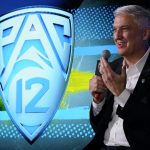Amid all the tumult and the pouting that engulfed two departing Pac-12 football programs over the past 10 days, Jedd Fisch uttered 14 words that said everything.
Following his move from Arizona to Washington, Fisch offered this bit of insight: “The Big Ten and the SEC right now are who’s leading the football pathways.”
They aren’t just leading the pathways. The two heavyweight conferences are clearing the brush, paving the road and charging others to pass.
While they aren’t everything in college football, the Big Ten and SEC are rapidly consolidating their hegemony over the sport.
The latest evidence surfaced immediately following the national championship game on Jan. 8, in what was effectively the first week of the 2024 season — and the first sentence of the first chapter of the sport’s new era.
Wednesday: Alabama coach Nick Saban announces his retirement.
Friday: Alabama hires Kalen DeBoer away from Washington.
Sunday: Washington hires Fisch away from Arizona.
The furor came against the backdrop of collapse. Washington’s loss to Michigan marked the final game played under the Pac-12 football banner as we know it.
In that regard, Washington’s successful poaching of Arizona’s coach marked the first act of Big Ten-on-Big 12 violence.
Relevant numbers (approximate):
— $3 million: Fisch’s annual salary at Arizona in 2023
— $5 million: Arizona’s (reported) contract extension offer to Fisch
— $7.8 million: Fisch’s average salary at Washington
And there will be more examples, many more.
Whether the Big Ten serves as the aggressor or the SEC fills the role, those conferences will rule the sport with unprecedented power and influence.
NCAA legislative issues, FBS matters, media rights dollars, College Football Playoff berths — whatever the issue, the Big Ten and SEC will lead the way.
“That’s why we coach,” Fisch added, “to be able to take a seat at that table and give yourself a chance every single year with resources beyond belief.”
It’s a table for two.
The Big 12 and ACC? They will be seated nearby. And a few feet from them, you’ll find the ‘Pac-2’ schools and the Group of Five.
More relevant numbers:
— Average annual value of head coaching contracts (football) for the four Pac-12 schools headed to the Big Ten: $7.8 million. (The figure assumes $10 million annually for USC’s Lincoln Riley.)
— Average annual value of head coaching contracts for the four Pac-12 schools headed to the Big 12: $5.1 million.
The disparity will only grow as the revenue reality takes hold.
Not only are the Big Ten and SEC schools set to receive tens of million more annually in media rights; they also will reap the benefits of sending at least three and perhaps four teams to the College Football Playoff.
The ACC and Big 12 will be fortunate to send two teams to the expanded CFP.
By the second half of the decade, the resource hierarchy within college football will resemble those Russian Matryoshka dolls of decreasing size with the top football schools in the Big Ten and the SEC outspending everyone, followed by other members of those conferences, then the top schools in the ACC and Big 12, the remaining schools in those leagues, then the top of the Group of Five and, finally, the bottom of the barrel in the FBS.
It’s like that now, just not as pronounced as it will become in the era of the Power Two.
Arizona is having financial troubles, but Washington is entering the Big Ten at a 50 percent discount. Yet the Huskies still swooped in and paid Fisch 55 percent more than the Wildcats could muster — before all that Big Ten playoff money starts flowing.
“The Big Ten and the SEC right now are who’s leading the football pathways.”
The Pac-12 (as we know it) has been gone for just two weeks, yet the world created following its demise is crystalizing before our eyes.
Other thoughts on the Washington and Arizona coaching changes:
— Fans of both schools have the right to ask if the departures could have been prevented. Were the administrations in Seattle and Tucson as proactive as they should have been with contract extensions for DeBoer and Fisch, respectively?
Granted, the topic presumes both coaches preferred to stay. Given Alabama’s position on the pantheon and the ambition apparent in Fisch’s resume, their desire to remain in place should be viewed with a hefty amount of skepticism.
But the Hotline believes the Huskies, to a greater extent than the Wildcats, could have done more despite tricky timing.
Athletic director Jen Cohen, who hired DeBoer, left for the same post at USC in late August. Her replacement, Troy Dannen, was hired in early October but didn’t get settled until weeks later. During those crucial two months, UW emerged as one of the hottest teams in the country.
Put another way: By the time UW beat Oregon on Oct. 14, it was clear that the momentum generated in 2022 had carried over, that DeBoer’s initial success was no fluke and that his $4.2 million salary was so far below market value you’d need a submersible to find it.
Yes, the Huskies placed an offer in the $8.5-million range on the table in late November. But by then, UW was on track for the playoff; DeBoer had hired Jimmy Sexton, the most powerful agent in the sport; and the coaching carousel was about to start spinning.
So we wonder: During that crucial stretch after Cohen left but before Dannen settled in, did the Huskies miss their chance? Should president Ana Mari Cauce have seen what was coming and been more proactive?
Had the Huskies offered DeBoer $9 million a year (with a huge buyout) in the rollicking, immediate aftermath of beating Oregon the first time, could they have locked him up?
We’ll never know — maybe he would have fled to Tuscaloosa anyhow. But it’s certainly a fair topic for discussion.
— The Hotline is less convinced there’s anything Arizona could have done to lock down Fisch.
Combine the whirlwind history — he hasn’t stayed in one place for more than three years since the mid-2000s — with Arizona’s limited contract offer and the lure of the Big Ten (and SEC), and the Wildcats faced a challenging situation.
Especially given the timing.
Arizona was 3-3 at midseason. It wasn’t until the back half of November that Fisch became one of the hottest coaching commodities in the country. And by then, the carousel was spinning.
We don’t know the details of Arizona’s discussions between Fisch and his agent (Doug Hendrickson of Wasserman Media).
But the space for second guessing is tighter in Tucson than it is in Seattle.
— The Huskies should be a tad nervous.
Fisch’s alma mater, Florida, could very well have a vacancy at the end of the 2024 season if Billy Napier doesn’t show substantial improvement in what will be his third season.
According to published reports, Fisch’s contract includes a buyout of $12 million to Washington if he leaves for another job before Jan. 8, 2025.
That wouldn’t stop the Gators.
— Arizona should have no such concerns about Brent Brennan, who has blood ties to the school and, in our view, will remain committed to the Wildcats.
The flight risk through the end of the decade is limited, and perhaps nonexistent.
In fact, we have wondered if, five years from now, the Hotline will look back on the Brennan hire as a better move for Arizona than the Fisch hire was for Washington.
The trajectories of the schools will be interlocked, relative to the strength of their new conferences, for years to come.
— Would Fisch have been positioned for the Washington job without the injury to Arizona quarterback Jayden de Laura?
After all, the unavoidable late-September switch to backup Noah Fifita ignited the Wildcats’ seven-game winning streak and made Fisch a hot property.
Had de Laura remained healthy and Arizona finished with eight wins instead of 10, for example, the Huskies might not have been interested.
Certainly, Fisch would have been a more difficult sell to UW constituents reeling from the DeBoer departure.
— Final (unanswerable) question: Did the Huskies give serious thought to luring Jonathan Smith away from Michigan State?
Had Smith remained at Oregon State through the bowl season, he would have been the obvious choice to replace DeBoer.
It’s not often that coaches leave their new employers behind after just two months, but there are no rules in the hiring game.
Of course, we don’t know if Smith would have listened to the Huskies. Perhaps a quick exit from East Lansing would have felt all wrong.
However, it’s worth noting that the buyout UW received from Alabama for DeBoer ($12 million) would have easily covered the reported cost of stealing Smith from Michigan State ($7 million).
Also, UW’s final offer to DeBoer (more than $9 million annually) is more than Smith’s average compensation ($8.8 million) from the Spartans. He’s a native Californian with deep roots in the Pacific Northwest and spent four years as UW’s playcaller under Chris Petersen.
But don’t mind us. We’re just thinking out loud.
*** Send suggestions, comments and tips (confidentiality guaranteed) to pac12hotline@bayareanewsgroup.
*** Follow me on Twitter: @WilnerHotline
*** Pac-12 Hotline is not endorsed or sponsored by the Pac-12 Conference, and the views expressed herein do not necessarily reflect the views of the Conference.
Related posts:

(AP Photo/Rick Scuteri)
Reactions to Pac-12 2022 Football Schedule Release
(AP Photo/Marcio Jose Sanchez)
Commissioner George Kliavkoff on the state of Pac-12 football (‘We’re in the valley’)
(AP Photo/Mark J. Terrill)
Wilner Hotline – UCLA Clarity with Kelly Staying, Unreal Uptick in Tucson, more…
Harry, the Washington Huskies mascot, (AP Photo/Ted S. Warren)
Washington’s MBB coaching search: Big Ten move offers Huskies huge opportunity to upgrade programJon Wilner
Jon Wilner has been covering college sports for decades and is an AP top-25 football and basketball voter as well as a Heisman Trophy voter. He was named Beat Writer of the Year in 2013 by the Football Writers Association of America for his coverage of the Pac-12, won first place for feature writing in 2016 in the Associated Press Sports Editors writing contest and is a five-time APSE honoree.
